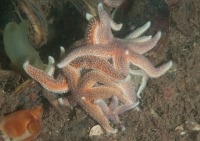
(Photo: Claire Goodwin)
Northern Sea Star
Asterias rubens
Yellow-brown to violet sea star. Can reach more than 50 centimetres in diameter, although most specimens are around 15 centimetres. Individuals usually have five arms. However, sometimes you see sea stars with short or missing arms. If they lose an arm to a predator or other misfortune, they can regrow it.
Authority
Linnaeus, 1758
Classification Details
Phylum: Echinodermata (echinoderms); Class: Asteroidea (sea stars).
Habitat
Very common in the Bay of Fundy and across the North Atlantic. Found on most types of seabed.
Diet
Predators. Eat urchins, worms, and other sea stars, as well as bivalve molluscs like mussels and scallops.
Reproduction
Sexes are separate. Males and females release sperm and eggs, respectively, and fertilization occurs in the seawater. The sea star larvae then float in the plankton for around 87 days (if they can avoid being eaten!) before settling on the seabed and growing into adult sea stars. Adults live up to 10 years.
Fun Facts
The common sea star can use the tube feet on its five arms to pry open a mussel. It then inserts its stomach into the mussel shell to digest the animal inside.
References
Budd GC (2008) Asterias rubens Common starfish. In Tyler-Walters H. and Hiscock K. (eds) Marine Life Information Network: Biology and Sensitivity Key Information Reviews, [on–line]. Plymouth: Marine Biological Association of the United Kingdom. Disponible depuis : https://www.marlin.ac.uk/species/detail/1194 Consulté en ligne le 19 janvier 2020.
Van Guelpen L, Pohle G, Vanden Berghe E and Costello MJ (2005) Marine Species Registers for the North Atlantic Ocean. Publication électronique sur le World Wide Web. http://www.vliz.be/vmdcdata/narms/


